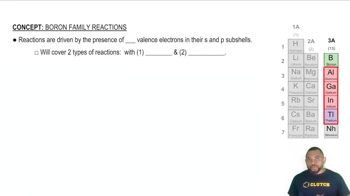Balance the following equations: c. NaHCO3(𝑠)+H2SO4(𝑎𝑞)⟶CO2(𝑔)+H2O(𝑙)+Na2SO4(𝑎𝑞)
Write balanced chemical equations to correspond to each of the following descriptions: (b) Boron sulfide, B2S31s2, reacts violently with water to form dissolved boric acid, H3BO3, and hydrogen sulfide gas.

Verified Solution
Key Concepts
Chemical Equations

Reactivity of Boron Compounds

Acid-Base Reactions

Balance the following equations: d, NaN3(𝑠)+HNO2(𝑎𝑞)⟶N2(𝑔)+NO(𝑔)+NaOH(𝑎𝑞)
Write balanced chemical equations corresponding to each of the following descriptions: c. Solid zinc metal reacts with sulfuric acid to form hydrogen gas and an aqueous solution of zinc sulfate.
Write balanced chemical equations to correspond to each of the following descriptions: (c) Phosphine, PH31g2, combusts in oxygen gas to form water vapor and solid tetraphosphorus decaoxide.
Write balanced chemical equations to correspond to each of the following descriptions: (d) When solid mercury(II) nitrate is heated, it decomposes to form solid mercury(II) oxide, gaseous nitrogen dioxide, and oxygen.
(a) When a compound containing C, H, and O is completely combusted in air, what reactant besides the hydrocarbon is involved in the reaction?
